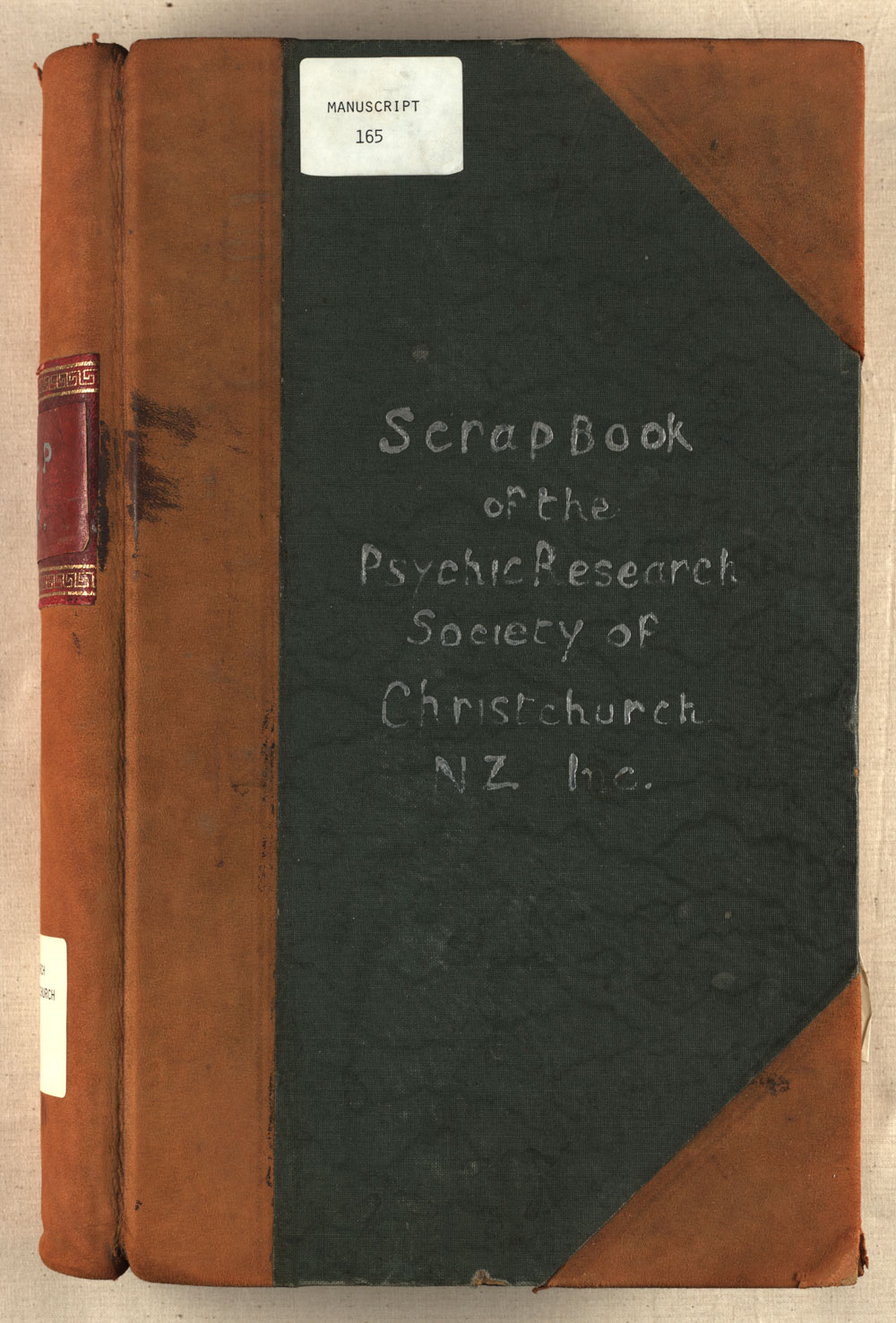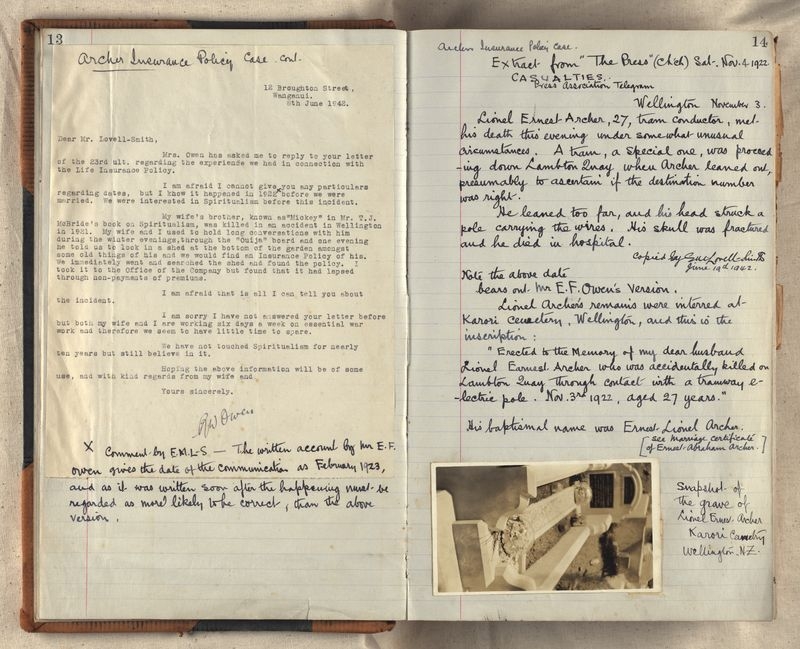The Scrapbook itself is a thick volume bound in dark cloth and faded brown velvet, with some gilding. Its marbled page edges (invisible in the digitised version) testify to a post-Victorian culture of scrapbooks and collecting. This was the era when Spiritualism first took off, that age imprinted onto the theory itself. Inside is a collection of newspaper articles, letters and séance transcripts, filling 186 pages of a seven hundred total. It testifies to the mysterious origins and disappearance of the Psychical Research Society: its high aspirations, evidenced by the small amount actually collected.

The Scrapbook
Lovell-Smith's Scrapbook begins with a collection of recollections of paranormal events, some that occurred at the séance, others in letters. Any one incident is typically followed by letters attempting to trace the evidence for such a story; tracing the story of the Archer family in Linwood whose dead son helped them to find an insurance policy in the back shed, nine letters to insurance companies in New Zealand, Australia and Britain searched for the name, but returned no name at all.
From here, the contents of the scrapbook diversify, containing the lengthy series of New Zealand and British newspaper articles going back to 1876, discussing Spiritualist photography, local incidents, and hoaxes. The late Prime Minister, Richard Seddon, comes back from the dead, ‘he being dead, yet speaketh’, offering enlightenment for all who leave their stubbornness to become ‘spiritual children’. Distinctly less reassuring is Henry Slade, the self-styled ‘Doctor’ whose rappings turned out to be an ingenious mechanism in his table, offering insight into the mind of the Spiritualist.

The Victorian charlatan offers signs of a keen desire to discover the truth behind spurious local phenomena, as well as a certain degree of trepidation. What accusations of fraud could the Christchurch Spiritualists fear, given such a history of scepticism? This combination of theory, analysis and anecdote offers a unique map of the Spiritualist mind, curious, inquisitive, yet with anxiety just below the surface.
More theoretical articles can also be found. The phantom nun Sister Monica, in her favourite haunts of Christchurch and Wellington, offers a guide to the occult properties of coloured light, a useful tool during a séance. Gold is the highest colour, and gold light indicates the highest and best sort of spirit. Blue indicates that one is capable of spiritual withdrawal, but cold blues indicate that the person is cold. Pink indicates earthly devotion and self-sacrifice. Red means power, but also anger; bright indicates a good soul, muddy and dark reds a bad sort. Green indicates prosperity and strength, health, but a dull green or khaki is ominous. Purple-violet is a seeker of truth and power, with a good character; blue rings usually there, meaning harmony. But above all is white, the highest ‘vibration’ of all colours, indicative of a true spiritual connection.
Despite the darkened rooms where the spirits came out, the Spiritualists were obsessed with light, and the British occult journal The Harbinger of Light was a comfort to those alienated by the dark years of the early twentieth century. International currents can be found; the famous Armistice Day photograph of 1919, where the apparent ghosts of the war dead cloud a minute’s silence. Such images had long been disproven, but continued to transfix the popular imagination, with death around every corner.

Other Sources
As rich as the Scrapbook is, other sources offer vivid insights into the darkened rooms of Chancery Lane, between Cathedral Square and Gloucester Street, where the group met. Canterbury Museum boasts ample collections of Spirit Writing collected by the Society. These writings and drawings, scrawled in a trance by a medium, offer a frustrating challenge to the reader, but nevertheless have their own power. These frail sheets are not studies of the occult from a distance, but its direct product. More accessible are the messages from a Ouija board. Taken from the French and German words for ‘yes’, Ouija had begun its life as a parlour game in the 1890s, but by the deathly years of World War I, mediums were using it to spell out messages from the other world. The Psychic Research Society appears to have used a Ouija sheet, with the letters and numbers written on an ample sheet of paper which nestles among the writings which came out. The messages from it are far more legible, and Edgar saw his grandmother come back to offer old-time spiritual advice, with a quick greeting from Kate Sheppard, who had boarded with the family. These brittle sheets and notebooks also have Lovell-Smith’s search for his infamous Baronet ancestor, outlawed in the eighteenth century. The fuller Ouija transcript is more helpful than the myriad disjointed fragments of the Spirit writing, suggesting a latter recourse when all was done.
Within these notebooks, clippings and letters, the famous and obscure, sublime and ridiculous mingle, a little-known chapter in Christchurch’s history, wandering the haunted streets of the Garden City.
Scrapbook of the Christchurch Psychical Research Society Inc., Macmillan Brown Library, University of Canterbury Manuscript 165, 67